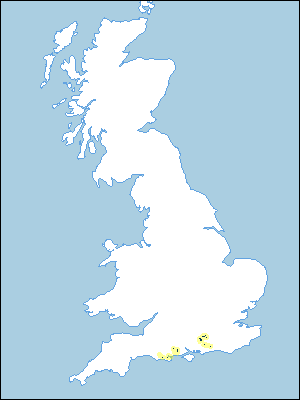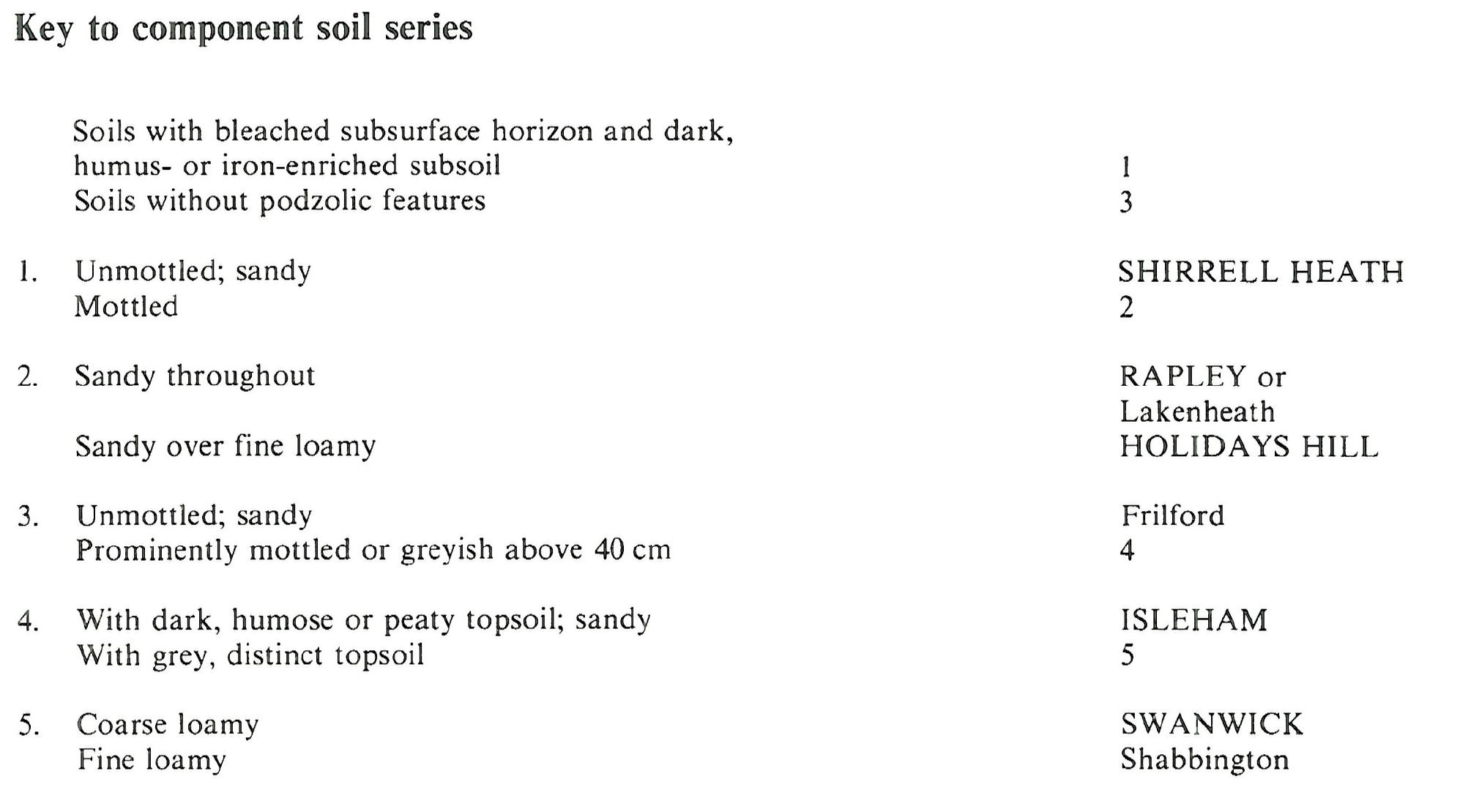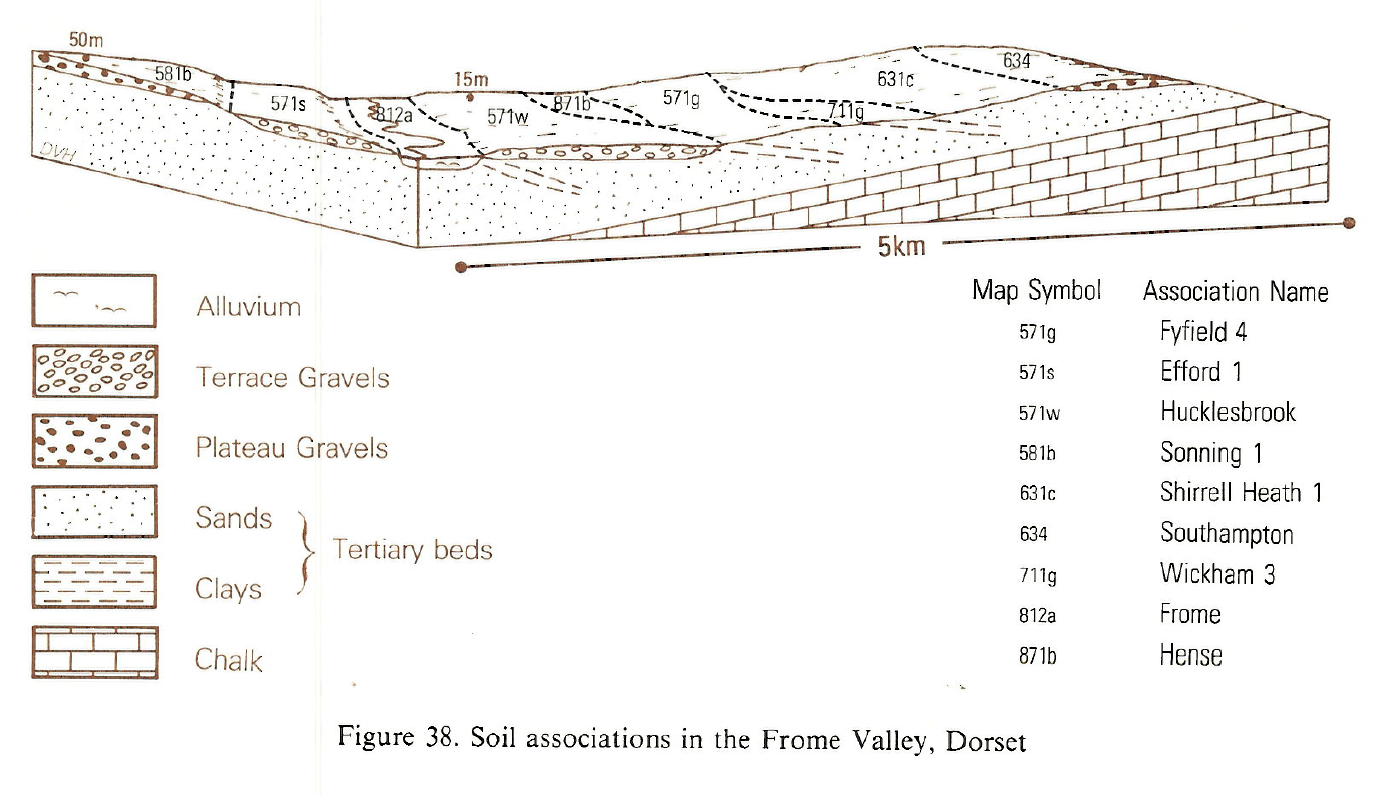
Soil Associations
0631c SHIRRELL HEATH 1
Soil and site characteristics
Well drained very acid sandy soils with a bleached subsurface horizon. Some similar soils with slowly permeable subsoils and slight seasonal waterlogging. Some sandy and coarse loamy soils affected by groundwater often with humose surface horizon.
Geology
Cretaceous and Tertiary sand
Cropping and Land Use
Coniferous woodland and lowland heath habitats; recreation; some military use.
Component soil series
| Subgroup | Series name | Percentage | WRB 2006 link |
|---|---|---|---|
| 6.31 | SHIRRELL HEATH | 40% | Albic Podzols |
| 6.43 | RAPLEY | 15% | Endostagnic Albic Carbic Podzols |
| 6.43 | HOLIDAYS HILL | 15% | Ruptic Stagnic Albic Carbic Podzols |
| 8.61 | ISLEHAM | 10% | Arenic Mollic Gleysols |
| 8.41 | SWANWICK | 10% | Luvic Gleysols |
Covers 143 km2 in England and Wales
Soilscapes Classification
| 14 |
Freely draining very acid sandy and loamy soils |
0631c SHIRRELL HEATH 1
Detailed Description
This association includes a range of sandy and loamy soils under dry heath, woodland and bog in the Weald, and locally on Tertiary beds in Dorset and western Hampshire. It is found on Reading Beds near Puddletown in Dorset, on Bagshot sands on Brownsea Island and Arne Heath, and on Bracklesham Beds and river terrace and Plateau gravel between Matchams Park and St Ives. Very acid Shirrell Heath soils, sandy humo-ferric podzols, are dominant; similar humus podzols, Leziate series are comparatively rare. Where there are clay seams in the Tertiary beds, Holidays Hill series, stagnogley-podzols, are found. Stony Redlodge and Southampton soils are found locally in gravelly drift. Sollom soils are present in basin sites affected by groundwater, associated with Rapley, Isleham and Swanwick soils.
The association occurs in the northern Weald on Folkestone and Sandgate Beds, mainly in two large areas centred on Woolmer Forest and Hankley Common. Smaller delineations occur around Ambersham Common, Greatham Common and Parham Park, along the Lower Greensand outcrop north of the South Downs. Most of the land is wooded, but the open country ranges from dry heathland to valley mire, with a wide range of groundwater conditions. Peat is locally extensive flanking the river Wey, particularly where tributaries meet the main river. On farmland there are well drained sandy Frilford and coarse loamy Fyfield soils with wetter Swanwick and Shabbington soils on lower ground.
In Hampshire there are small areas in the western New Forest and in Ringwood Forest, mainly on sandy and clayey Barton Beds. Here, stony Redlodge soils are present on hilltops capped by river terrace and Plateau Gravel. There are some Leziate soils, humus podzols with iron-enriched subsoil layers, and Sollom soils in wet basin sites. Rapley, Isleham and Swanwick soils also occur.
Soil Water Regime
The dominant Shirrell Heath soils are permeable and well drained (Wetness Class I) but the associated Rapley and Holidays Hill soils have less permeable compact or fine textured subsoil layers and are occasionally or seasonally waterlogged (Wetness Class II or III). Isleham and Swanwick soils are affected by groundwater and are waterlogged for long periods in winter (Wetness Class III or IV). They are difficult to drain because there is usually little fall to the streams and there is a risk of flooding in winter. The available water reserves in Shirrell Heath soils are small and droughtiness is a severe limitation for most crops.
Cropping and Land Use
Because the soils are coarse textured, infertile and often stony, much land is uncultivated and remains under woodland, forest or heathland. The better drained very acid and droughty Shirrell Heath, Rapley and Holidays Hill soils require heavy application of fertilizers and lime for successful cropping. There is some permanent grassland on lsleham and Swanwick soils and this has been improved in places by reseeding for use as summer grazing.
Pines, especially Corsican pine and Scots pine with their tap-root systems, are particularly successful as they can extract nutrients from horizons below the nutrient-depleted podzol horizons. Corsican pine yields better than Scots pine and for both species growth is better in Sussex than in Surrey. Some Douglas fir is grown in Woolmer Forest. Nitrogen is, however, in short supply on some heathland with a history of burning. The deficiency is aggravated where heather is allowed to remain in the understorey, because it absorbs nitrogen from the surface humus. The ability of trees to extract water and nutrients depends on the development of their root systems, so it is important to break up compact iron and humus-enriched subsoil layers in Shirrell Heath, Rapley and Holidays Hill soils and this land is often deep-tine ploughed before planting. There are no systematic micronutrient deficiencies.
The association includes much land used by the armed forces or for recreation; some valued for its flora and fauna is protected. Areas with public access are popular because of the attractive countryside and dry walking conditions. Much of Hankley Common and Woolmer Forest are used for military purposes but they and similar areas are also valuable as relicts of agriculturally undisturbed land. The podzols of the heathlands and commons probably date from Mesolithic times, when man began to clear the land of its forest cover. Heathland species invaded, causing the onset of podzolization and soil infertility. The relatively undisturbed acid soil profiles preserve pollen that is useful in reconstructing the vegetation, climate and environment of post-glacial times. Most of the heathland was settled in prehistoric times, and so is valuable archaeologically. Tumuli and bell barrows are frequent, for example at The Warren, Oakhanger, Greatham Common and Longmoor Inclosure.
Many heathlands in the Weald are designated as Sites of Special Scientific Interest. Other heathland occurs in the New Forest. There is a wide range of vegetation types reflecting the variety of soils and groundwater conditions. Dry ericaceous heathland is usual on well drained Shirrell Heath soils and humid and wet heathland are common vegetation types on the less well drained soils as at Ambersham, Graffham, Lavington, Thursley, Hankley and Frensham Commons. Valley bog and mires occur on several commons, and they support a range of mire plant communities. Other vegetation types are found locally, for example, base-rich fen at Conford Moor, and acid grassland at Shortheath Common. Bracken (Pteridium aquilinum) and gorse (Ulex europaeus) have invaded some heathland, and spontaneous regeneration of birch and pine also occurs. The heathlands serve as important habitats for animals, some of them rare. Reptiles such as the sand lizard (Lacerta agilis) and smooth snake (Coronella austriaca) are found on drier sites, with the natterjack toad (Bufo calamita) in humid heathland at Blackmoor and Woolmer Forest. Several commons have interesting insect and spider faunas, whereas others support birds such as the Dartford warbler (Sylvia undata).
0631c SHIRRELL HEATH 1
Distribution Map
 |
Note that the yellow shading represents a buffer to highlight the location of very small areas of the association.
Keys to component soil series
South Eastern Region
 |
Typical Landscapes
South Western Region
 |
All information Copyright, Cranfield University © 2025
Citation: To use information from this web resource in your work, please cite this as follows:
Cranfield University 2025. The Soils Guide. Available: www.landis.org.uk. Cranfield University, UK. Last accessed 04/04/2025
